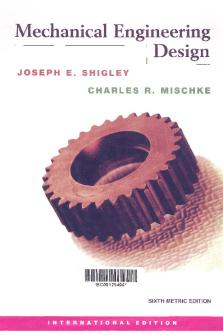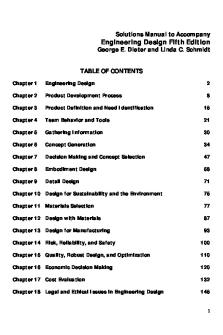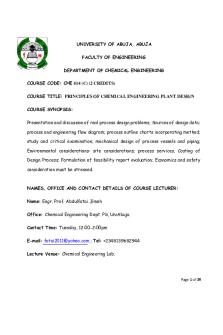Engineering Design - Dieter PDF

| Title | Engineering Design - Dieter |
|---|---|
| Author | Kennith Fuenmayor |
| Pages | 971 |
| File Size | 13.9 MB |
| File Type | |
| Total Downloads | 22 |
| Total Views | 510 |
Summary
ROADMAP to ENGINEERING DESIGN 3 4 5 6 7 Define Gather Concept Evaluate & problem information generation select concept Problem statement Internet Creativity methods Decision making Benchmarking Patents Brainstorming Selection criteria Product dissection Technical articles Functional models Pugh...
Description
ROADMAP to ENGINEERING DESIGN 3
4
5
6
7
Define problem
Gather information
Concept generation
Evaluate & select concept
Problem statement Benchmarking Product dissection House of Quality PDS
Internet Patents Technical articles Trade journals Consultants
Creativity methods Brainstorming Functional models Decomposition Systematic design methods
Decision making Selection criteria Pugh chart Decision matrix AHP
Conceptual design
8
10
Product architecture
11
12
13
13
Configuration design Preliminary selection of materials and manufacturing processes Modeling Sizing of parts
Arrangement of physical elements Modularity
8
Embodiment design
Chap.1 – The Engineering Design Process Chap.2 – The Product Development Process Chap.3 – Problem Definition and Need Identification Chap.4 – Team Behavior and Tools Chap.5 – Gathering Information Chap.6 – Concept Generation Chap.7 – Decision Making and Concept Selection Chap.8 – Embodiment Design Chap.9 – Detail Design Chap.10 – Modeling and Simulation
die37039_ch98_ifc.indd 1
14
15
16
9
16
Parametric design
Detail design
Robust design Set tolerances DFM, DFA, DFE Tolerances
Engineering drawings Finalize PDS
11 12
Chap.11 – Materials Selection Chap.12 – Design with Materials Chap.13 – Design for Manufacturing Chap.14 – Risk, Reliability, and Safety Chap.15 – Quality, Robust Design, and Optimization Chap.16 – Cost Evaluation Chap.17 – Legal and Ethical Issues in Engineering Design* Chap.18 – Economic Decision Making* *see www.mhhe.com/dieter
2/25/08 7:07:02 PM
ENGI N EER I NG DESIGN
die37039_ch00_fm.indd i
2/25/08 6:50:01 PM
die37039_ch00_fm.indd ii
2/25/08 6:50:01 PM
ENGINEERING DESIGN
FOURTH EDITION
George E. Dieter University of Maryland
Linda C. Schmidt University of Maryland
die37039_ch00_fm.indd iii
2/25/08 6:50:01 PM
ENGINEERING DESIGN, FOURTH EDITION Published by McGraw-Hill, a business unit of The McGraw-Hill Companies, Inc., 1221 Avenue of the Americas, New York, NY 10020. Copyright © 2009 by The McGraw-Hill Companies, Inc. All rights reserved. Previous editions © 2000, 1991, 1983. No part of this publication may be reproduced or distributed in any form or by any means, or stored in a database or retrieval system, without the prior written consent of The McGraw-Hill Companies, Inc., including, but not limited to, in any network or other electronic storage or transmission, or broadcast for distance learning. Some ancillaries, including electronic and print components, may not be available to customers outside the United States. This book is printed on acid-free paper. 1 2 3 4 5 6 7 8 9 0 DOC/DOC 0 9 8
ISBN 978–0–07–283703–2 MHID 0–07–283703–9 Global Publisher: Raghothaman Srinivasan Senior Sponsoring Editor: Bill Stenquist Director of Development: Kristine Tibbetts Developmental Editor: Lorraine K. Buczek Senior Project Manager: Kay J. Brimeyer Senior Production Supervisor: Laura Fuller Associate Design Coordinator: Brenda A. Rolwes Cover Designer: Studio Montage, St. Louis, Missouri Cover Illustration: Paul Turnbaugh (USE) Cover Image: Group of Students: © 2007, Al Santos, Photographer; Vacuum Roller: © Brian C. Grubel; Machinery: © John A. Rizzo/Getty Images; Gears and Machinery: © Nick Koudis/Getty Images; University Students Using Library Computers: BananaStock/ Jupiter Images Compositor: Newgen Typeface: 10.5/12 Times Roman Printer: R. R. Donnelley Crawfordsville, IN Library of Congress Cataloging-in-Publication Data Dieter, George Ellwood. Engineering design / George E. Dieter, Linda C. Schmidt. — 4th ed. p. cm. Includes bibliographical references and indexes. ISBN 978-0-07-283703-2 — ISBN 0-07-283703-9 (hard copy : alk. paper) 1. Engineering design. I. Schmidt, Linda C. II. Title. TA174.D495 2009 620⬘.0042—dc22 2007049735
www.mhhe.com
die37039_ch00_fm.indd iv
2/25/08 6:50:02 PM
ABOUT THE AUTHORS
G E O R G E E . D I E T E R is Glenn L. Martin Institute Professor of Engineering at the University of Maryland. The author received his B.S. Met.E. degree from Drexel University and his D.Sc. degree from Carnegie Mellon University. After a stint in industry with the DuPont Engineering Research Laboratory, he became head of the Metallurgical Engineering Department at Drexel University, where he later became Dean of Engineering. Professor Dieter later joined the faculty of Carnegie Mellon University as Professor of Engineering and Director of the Processing Research Institute. He moved to the University of Maryland in 1977 as professor of Mechanical Engineering and Dean of Engineering, serving as dean until 1994. Professor Dieter is a fellow of ASM International, TMS, AAAS, and ASEE. He has received the education award from ASM, TMS, and SME, as well as the Lamme Medal, the highest award of ASEE. He has been chair of the Engineering Deans Council, and president of ASEE. He is a member of the National Academy of Engineering. He also is the author of Mechanical Metallurgy, published by McGraw-Hill, now in its third edition. L I N DA C . S C H M I D T is an Associate Professor in the Department of Mechanical Engineering at the University of Maryland. Dr. Schmidt’s general research interests and publications are in the areas of mechanical design theory and methodology, design generation systems for use during conceptual design, design rationale capture, and effective student learning on engineering project design teams. Dr. Schmidt completed her doctorate in Mechanical Engineering at Carnegie Mellon University with research in grammar-based generative design. She holds B.S. and M.S. degrees from Iowa State University for work in Industrial Engineering. Dr. Schmidt is a recipient of the 1998 U.S. National Science Foundation Faculty Early Career Award for generative conceptual design. She co-founded RISE, a summer research experience that won the 2003 Exemplary Program Award from the American College Personnel Association’s Commission for Academic Support in Higher Education.
die37039_ch00_fm.indd v
2/25/08 6:50:02 PM
vi
engineer ing design
Dr. Schmidt is active in engineering design theory research and teaching engineering design to third- and fourth-year undergraduates and graduate students in mechanical engineering. She has coauthored a text on engineering decision-making, two editions of a text on product development, and a team-training curriculum for faculty using engineering student project teams. Dr. Schmidt was the guest editor of the Journal of Engineering Valuation & Cost Analysis and has served as an Associate Editor of the ASME Journal of Mechanical Design. Dr. Schmidt is a member of ASME, SME, and ASEE.
die37039_ch00_fm.indd vi
2/25/08 6:50:03 PM
BRIEF CONTENTS
Chapter 1 Chapter 2 Chapter 3 Chapter 4 Chapter 5 Chapter 6 Chapter 7 Chapter 8 Chapter 9 Chapter 10 Chapter 11 Chapter 12 Chapter 13 Chapter 14 Chapter 15 Chapter 16 Chapter 17 Chapter 18
Engineering Design Product Development Process Problem Definition and Need Identification Team Behavior and Tools Gathering Information Concept Generation Decision Making and Concept Selection Embodiment Design Detail Design Modeling and Simulation Materials Selection Design with Materials Design for Manufacturing Risk, Reliability, and Safety Quality, Robust Design, and Optimization Cost Evaluation Legal and Ethical Issues in Engineering Design Economic Decision Making
1 39 75 116 158 196 262 298 386 411 457 515 558 669 723 779 828 858
Appendices Author & Subject Indexes
A-1 I-1
vii
die37039_ch00_fm.indd vii
2/25/08 6:50:03 PM
DETAILED CONTENTS
Preface
Chapter 1
xxiii
Engineering Design 1.1 1.2
1.3
1.4
1.5
1.6 1.7 1.8
1
Introduction Engineering Design Process 1.2.1 Importance of the Engineering Design Process 1.2.2 Types of Designs Ways to Think About the Engineering Design Process 1.3.1 A Simplified Iteration Model 1.3.2 Design Method Versus Scientific Method 1.3.3 A Problem-Solving Methodology Considerations of a Good Design 1.4.1 Achievement of Performance Requirements 1.4.2 Total Life Cycle 1.4.3 Regulatory and Social Issues Description of Design Process 1.5.1 Phase I. Conceptual Design 1.5.2 Phase II. Embodiment Design 1.5.3 Phase III. Detail Design 1.5.4 Phase IV. Planning for Manufacture 1.5.5 Phase V. Planning for Distribution 1.5.6 Phase VI. Planning for Use 1.5.7 Phase VII. Planning for Retirement of the Product Computer-Aided Engineering Designing to Codes and Standards Design Review 1.8.1 Redesign 1.9 Societal Considerations in Engineering Design
1 3 4 5 6 6 8 10 14 14 17 18 19 19 20 21 22 23 23 23 24 26 29 30 31
viii
die37039_ch00_fm.indd viii
2/25/08 6:50:03 PM
detailed contents
1.10
Chapter 2
Product Development Process 2.1 2.2
2.3
2.4
2.5
2.6
2.7
Chapter 3
Introduction Product Development Process 2.2.1 Factors for Success 2.2.2 Static Versus Dynamic Products 2.2.3 Variations on the Generic Product Development Process Product and Process Cycles 2.3.1 Stages of Development of a Product 2.3.2 Technology Development and Insertion Cycle 2.3.3 Process Development Cycle Organization for Design and Product Development 2.4.1 A Typical Organization by Functions 2.4.2 Organization by Projects 2.4.3 Hybrid Organizations 2.4.4 Concurrent Engineering Teams Markets and Marketing 2.5.1 Markets 2.5.2 Market Segmentation 2.5.3 Functions of a Marketing Department 2.5.4 Elements of a Marketing Plan Technological Innovation 2.6.1 Invention, Innovation, and Diffusion 2.6.2 Business Strategies Related to Innovation and Product Development 2.6.3 Characteristics of Innovative People 2.6.4 Types of Technology Innovation Summary New Terms and Concepts Bibliography Problems and Exercises
Problem Definition and Need Identification 3.1 3.2
3.3
die37039_ch00_fm.indd ix
Summary New Terms and Concepts Bibliography Problems and Exercises
Introduction Identifying Customer Needs 3.2.1 Preliminary Research on Customers Needs 3.2.2 Gathering Information from Customers Customer Requirements 3.3.1 Differing Views of Customer Requirements 3.3.2 Classifying Customer Requirements
ix 35 36 37 37
39 39 39 43 46 46 47 47 48 50 51 53 54 55 57 58 59 60 63 63 64 64 67 68 69 71 72 72 73
75 75 77 79 80 86 87 89
2/25/08 6:50:03 PM
x
engineer ing design
3.4
3.5
3.6 3.7
Chapter 4
Team Behavior and Tools 4.1 4.2 4.3 4.4 4.5 4.6 4.7 4.8 4.9
4.10
Chapter 5
Introduction What It Means to be an Effective Team Member Team Roles Team Dynamics Effective Team Meetings 4.5.1 Helpful Rules for Meeting Success Problems with Teams Problem-Solving Tools 4.7.1 Applying the Problem-Solving Tools in Design Time Management Planning and Scheduling 4.9.1 Work Breakdown Structure 4.9.2 Gantt Chart 4.9.3 Critical Path Method Summary New Terms and Concepts Bibliography Problems and Exercises
Gathering Information 5.1
5.2 5.3 5.4
die37039_ch00_fm.indd x
Establishing the Engineering Characteristics 3.4.1 Benchmarking in General 3.4.2 Competitive Performance Benchmarking 3.4.3 Reverse Engineering or Product Dissection 3.4.4 Determining Engineering Characteristics Quality Function Deployment 3.5.1 The House of Quality Configurations 3.5.2 Steps for Building a House of Quality 3.5.3 Interpreting Results of HOQ Product Design Specification Summary Bibliography New Terms and Concepts Problems and Exercises
The Information Challenge 5.1.1 Your Information Plan 5.1.2 Data, Information, and Knowledge Types of Design Information Sources of Design Information Library Sources of Information 5.4.1 Dictionaries and Encyclopedias 5.4.2 Handbooks 5.4.3 Textbooks and Monographs
91 93 95 96 97 98 100 102 107 109 111 113 114 114
116 116 117 118 119 122 123 124 126 140 145 146 147 147 149 154 155 155 156
158 158 159 160 162 162 166 167 169 169
2/25/08 6:50:03 PM
detailed contents
5.5 5.6
5.7 5.8 5.9
5.10 5.11
Chapter 6
Concept Generation 6.1
6.2
6.3
6.4
6.5
die37039_ch00_fm.indd xi
5.4.4 Finding Periodicals 5.4.5 Catalogs, Brochures, and Business Information Government Sources of Information Information From the Internet 5.6.1 Searching with Google 5.6.2 Some Helpful URLs for Design 5.6.3 Business-Related URLs for Design and Product Development Professional Societies and Trade Associations Codes and Standards Patents and Other Intellectual Property 5.9.1 Intellectual Property 5.9.2 The Patent System 5.9.3 Technology Licensing 5.9.4 The Patent Literature 5.9.5 Reading a Patent 5.9.6 Copyrights Company-Centered Information Summary New Terms and Concepts Bibliography Problems and Exercises
Introduction to Creative Thinking 6.1.1 Models of the Brain and Creativity 6.1.2 Thinking Processes that Lead to Creative Ideas Creativity and Problem Solving 6.2.1 Aids to Creative Thinking 6.2.2 Barriers to Creative Thinking Creative Thinking Methods 6.3.1 Brainstorming 6.3.2 Idea Generating Techniques Beyond Brainstorming 6.3.3 Random Input Technique 6.3.4 Synectics: An Inventive Method Based on Analogy 6.3.5 Concept Map Creative Methods for Design 6.4.1 Refinement and Evaluation of Ideas 6.4.2 Generating Design Concepts 6.4.3 Systematic Methods for Designing Functional Decomposition and Synthesis 6.5.1 Physical Decomposition 6.5.2 Functional Representation 6.5.3 Performing Functional Decomposition 6.5.4 Strengths and Weaknesses of Functional Synthesis
xi 169 171 171 172 174 176 178 180 181 183 184 185 187 187 189 191 192 193 194 194 194
196 197 197 201 202 202 205 208 208 210 212 213 215 217 217 219 221 222 223 225 229 232
2/25/08 6:50:04 PM
xii
engineer ing design
6.6
6.7
6.8
6.9
Chapter 7
Decision Making and Concept Selection 7.1 7.2
7.3
7.4
Chapter 8
Introduction Decision Making 7.2.1 Behavioral Aspects of Decision Making 7.2.2 Decision Theory 7.2.3 Utility Theory 7.2.4 Decision Trees Evaluation Methods 7.3.1 Comparison Based on Absolute Criteria 7.3.2 Pugh Concept Selection Method 7.3.3 Measurement Scales 7.3.4 Weighted Decision Matrix 7.3.5 Analytic Hierarchy Process (AHP) Summary New Terms and Concepts Bibliography Problems and Exercises
Embodiment Design 8.1
die37039_ch00_fm.indd xii
Morphological Methods 6.6.1 Morphological Method for Design 6.6.2 Generating Concepts from Morphological Chart TRIZ: The Theory of Inventive Problem Solving 6.7.1 Invention: Evolution to Increased Ideality 6.7.2 Innovation by Overcoming Contradictions 6.7.3 TRIZ Inventive Principles 6.7.4 The TRIZ Contradiction Matrix 6.7.5 Strengths and Weaknesses of TRIZ Axiomatic Design 6.8.1 Axiomatic Design Introduction 6.8.2 The Axioms 6.8.3 Using Axiomatic Design to Generate a Concept 6.8.4 Using Axiomatic Design to Improve an Existing Concept 6.8.5 Strengths and Weaknesses of Axiomatic Design Summary New Terms and Concepts Bibliography Problems and Exercises
Introduction 8.1.1 Comments on Nomenclature Concerning the Phases of the Design Process 8.1.2 Oversimplification of the Design Process Model
233 234 236 237 238 239 240 243 247 249 249 250 251 253 257 258 259 260 260
262 262 263 263 266 269 273 274 275 277 280 282 285 292 294 294 294
298 298 299 300
2/25/08 6:50:04 PM
detailed contents
8.2
8.3
8.4
8.5
8.6
8.7 8.8
8.9
8.10
die37039_ch00_fm.indd xiii
Product Architecture 8.2.1 Types of Modular Architectures 8.2.2 Modularity and Mass Customization 8.2.3 Create the Schematic Diagram of the Product 8.2.4 Cluster the Elements of the Schematic 8.2.5 Create a Rough Geometric Layout 8.2.6 Define Interactions and Determine Performance Characteristics Configuration Design 8.3.1 Generating Alternative Configurations 8.3.2 Analyzing Configuration Designs 8.3.3 Evaluating Configuration Designs Best Practices for Configuration Design 8.4.1 Design Guidelines 8.4.2 Interfaces and Connections 8.4.3 Checklist for Configuration Design 8.4.4 Design Catalogs Parametric Design 8.5.1 Systematic Steps in Parametric Design 8.5.2 A Parametric Design Example: Helical Coil Compression Spring 8.5.3 Design for Manufacture (DFM) and Design for Assembly (DFA) 8.5.4 Failure Modes and Effects Analysis (FMEA) 8.5.5 Design for Reliability and Safety 8.5.6 Design for Quality and Robustness Dimensions and Tolerances 8.6.1 Dimensions 8.6.2 Tolerances 8.6.3 Geometric Dimensioning and Tolerancing 8.6.4 Guidelines for Tolerance Design Industrial Design 8.7.1 Visual Aesthetics Human Factors Design 8.8.1 Human Physical Effort 8.8.2 Sensory Input 8.8.3 Anthropometric Data 8.8.4 Design for Serviceability Design for the Environment 8.9.1 Life Cycle Design 8.9.2 Design for the Environment (DFE) 8.9.3 DFE Scoring Methods Prototyping and Testing 8.10.1 Prototype and Model Testing Throughout the Design Process 8.10.2 Building Prototypes
xiii 301 303 303 305 306 307 308 309 312 315 315 316 317 321 324 325 325 326 328 336 337 337 338 338 339 340 350 355 356 357 358 359 361 364 364 365 366 368 370 370 371 372
2/25/08 6:50:04 PM
xiv
engineer ing design
8.11 8.12
Chapter 9
Detail Design 9.1 9.2 9.3
9.4
9.5 9.6
9.7
Chapter 10
Introduction Activities and Decisions in Detail Design Communicating Design and Manufacturing Information 9.3.1 Engineering Drawings 9.3.2 Bill of Materials 9.3.3 Written Documents 9.3.4 Common Challenges in Technical Writing 9.3.5 Meetings 9.3.6 Oral Presentations Final Design Review 9.4.1 Input Documents 9.4.2 Review Meeting Process 9.4.3 Output from Review Design and Business Activities Beyond Detail Design Facilitating Design and Manufacturing with Computer-Based Methods 9.6.1 Product Lifecycle Management (PLM) Summary New Terms and Concepts Bibliography Problems and Exercises
373 374 377 378 380 382 382 383 383
386 386 387 391 391 394 395 398 399 400 402 402 403 403 403 406 407 408 408 409 409
Modeling and Simulation
411
10.1
411 412 413 414 414 423 425 429 432 434 435 439
10.2 10.3 10.4 10.5 10.6
die37039_ch00_fm.indd xiv
8.10.3 Rapid Prototyping 8.10.4 RP Processes 8.10.5 Testing 8.10.6 Statistical Design of Testing Design for X (DFX) Summary New Terms and Concepts Bibliography Problems and Exercises
The Role of Models in Engineering Design 10.1.1 Types of Models 10.1.2 Iconic, Analog, and Symbolic Models Mathematical Modeling 10.2.1 The Model-Building Process Dimensional Analysis 10.3.1 Similitude and Scale Models Finite-Difference Method Geo...
Similar Free PDFs

Engineering Design - Dieter
- 971 Pages

Engineering design handbook
- 110 Pages

Mechanical engineering design
- 6 Pages

chemical engineering design project
- 383 Pages

Basic Engineering Design Project
- 54 Pages
Popular Institutions
- Tinajero National High School - Annex
- Politeknik Caltex Riau
- Yokohama City University
- SGT University
- University of Al-Qadisiyah
- Divine Word College of Vigan
- Techniek College Rotterdam
- Universidade de Santiago
- Universiti Teknologi MARA Cawangan Johor Kampus Pasir Gudang
- Poltekkes Kemenkes Yogyakarta
- Baguio City National High School
- Colegio san marcos
- preparatoria uno
- Centro de Bachillerato Tecnológico Industrial y de Servicios No. 107
- Dalian Maritime University
- Quang Trung Secondary School
- Colegio Tecnológico en Informática
- Corporación Regional de Educación Superior
- Grupo CEDVA
- Dar Al Uloom University
- Centro de Estudios Preuniversitarios de la Universidad Nacional de Ingeniería
- 上智大学
- Aakash International School, Nuna Majara
- San Felipe Neri Catholic School
- Kang Chiao International School - New Taipei City
- Misamis Occidental National High School
- Institución Educativa Escuela Normal Juan Ladrilleros
- Kolehiyo ng Pantukan
- Batanes State College
- Instituto Continental
- Sekolah Menengah Kejuruan Kesehatan Kaltara (Tarakan)
- Colegio de La Inmaculada Concepcion - Cebu










